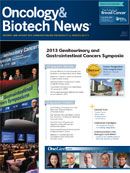Publication
Article
Oncology & Biotech News
The Economic Value of Ipilimumab as a Second-Line Treatment in Patients With Advanced Melanoma
Author(s):
Analysis of the cost-effectiveness of ipilimumab compared with best supportive care in previously treated patients with advanced (unresectable or metastatic) melanoma.
In early 2011, ipilimumab, an anti—CTLA-4 monoclonal antibody with antitumor activity, was approved by the FDA for the treatment of advanced melanoma. Ipilimumab was compared with the gp100 vaccine in a clinical trial, and patients survived a median of 3.7 months longer than those receiving the vaccine. In another trial, ipilimumab with dacarbazine was compared with dacarbazine alone in previously untreated patients with advanced melanoma. The investigators found that combination therapy yielded higher survivals at 1, 2, and 3 years.
Ipilimumab is an expensive treatment that is associated with positive clinical outcomes. Researchers from the United States and United Kingdom (and from Bristol-Myers Squibb, the manufacturer of ipilimumab) sought to evaluate the cost-effectiveness of ipilimumab compared with best supportive care in previously treated patients with advanced (unresectable or metastatic) melanoma.
Progression-free and overall survival data were used from a phase III trial of ipilimumab to model stable disease, progression, and death. Clinical outcomes, quality of life, and healthcare utilization were included in the analyses. The Markov model considered only the direct costs in patients with an average age of 55 years having advanced melanoma. A discount rate of 3% was utilized for both costs and outcomes.
Because no previous clinical trial with another therapy demonstrated a prolongation of survival, best supportive care was defined as disease management without active chemotherapy. The researchers acknowledged that this may provide a conservative cost benefit for ipilimumab, as most patients usually receive some type of chemotherapy that increases treatment costs of advanced melanoma. Both the incremental cost-effectiveness ratio (ICER) and incremental cost utility ratio (ICUR) were estimated in the model. They included direct costs associated with pharmaceuticals, clinical management, and costs associated with toxicity-related events (Table).
Table. Costs Used in the Cost-Effectiveness Model
Parameter
Value
Drug Costs
• Ipilimumab cost per cycle
$30,000
• Ipilimumab administration
$504
• Weekly cost for third-line treatment
$89
On-treatment disease management costs
• Ipilimumab
$822
• Best supportive care
$1518
Off-treatment disease management costs
• Ipilimumab
$1518
• Best supportive care
$1518
Estimated average treatment costs per toxicity
• Costs varied by the respective toxicity
$775-$8563a
aFor example, an episode of anemia was assigned an average treatment cost of $851, and fever was assigned a cost of $3304.
Source: Barzey V, Atkins MB, Garrison LP, et al. Ipilimumab in 2nd line treatment of patients with advanced melanoma: a cost-effectiveness analysis. J Med Econ. 2013;16(2):202-212.
The model used ipilimumab clinical data from a trial comparing the agent with gp100, dacarbazine, interleukin-2, and temozolomide. Ipilimumab demonstrated benefits in both progression-free and overall survival.
Those in the ipilimumab group demonstrated a mean gain of 1.88 life-years and 1.14 quality-adjusted life-years (QALYs) compared with patients receiving basic supportive care. The drug costs were higher in the ipilimumab group. They estimated the incremental cost-effectiveness ratios to be $78,000 per life-year gained and $129,000 for the incremental cost per QALY gained.
Based on their sensitivity analysis, and assuming a willingness-to-pay threshold of $113,000 per QALY, the researchers estimated a 6% chance that ipilimumab would be considered cost-effective. However, if the threshold were raised to $146,000/ QALY, ipilimumab would be considered cost-effective in better than 95% of the scenarios.
The investigators explained that the differences between the ICER and ICUR were expected, owing to the definitions utilized for disease progression from stable disease to progressive disease in the model. Using the costs of alternative therapies that have not shown benefit in survival would increase the cost-effectiveness of ipilimumab, as this therapy has been proven to improve survival.
Barzey V, Atkins MB, Garrison LP, et al. Ipilimumab in 2nd line treatment of patients with advanced melanoma: a cost-effectiveness analysis. J Med Econ. 2013;16(2):202-212.










